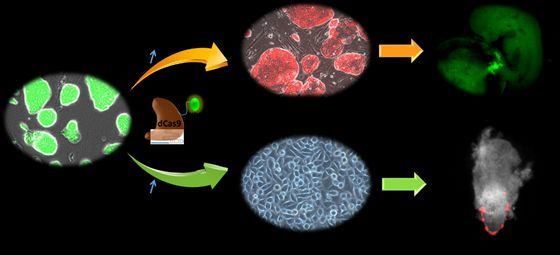Conversion of embryonic stem cells into extraembryonic lineages by CRISPR-mediated activators
Recently, a site-specific nuclease clustered regularly interspaced short palindromic repeats (CRISPR)/CRISPR-associated (Cas) 9 system has been engineered to target and edit specific genome sites through a synthetic single-guided RNA (sgRNA) with simple base-pair complementarities. Compared with the fixed DNA sequence-binding repetitive composition requirements of ZFNs and TALEs, the RNA-guide platform is fairly easy to master and practice. The CRISPR/Cas9 system has been used for genome editing in different organisms, including prokaryotes and eukaryotes. Moreover, by fusing with a mutant Cas9 protein lacking endonuclease activity (dCas9) with transactivator VP64 or repressor KRAB, the fusion proteins can be guided to the desired promoter regions and modulate up-or down-regulation of endogenous gene expression.
The CRISPR-mediated activator system has been used for the activation of specific endogenous genes, and is beneficial for the study of gene function, gene therapy, and genetic reprogramming. In addition, CRISPR-mediated activator system can also be used to manipulate the expression of endogenous non-coding RNAs that exist in untranslated regions and play important roles in cell fate regulation. Through the direct control of endogenous specific gene expression, CRISPR-mediated activator system provides a novel, low-cost and promising method for reprogramming cell lineage specification.
Prof Lai liangxue and his group fused VP64 with dCas9, and designed sgRNAs to target the promoter regions of Cdx2 and Gata6. By co-transfection of the fused proteins and sgRNAs, they succeeded in activating endogenous Cdx2 and Gata6 in mESCs, thus converting ESCs into TSCs and XENCs, respectively. Their study provides an effective approach to manipulate cell fate by directly activating specific endogenous genes using only CRISPR-mediated activator system. This technique can be used to study other biological processes such as cell reprogramming or transdifferentiation.
Overall, Prof Lai and his group proved that activation of endogenous Cdx2 and Gata6 could be effectively realized by fusion of a single VP64 with dCas9 and cell fate can be effectively manipulated by directly activating of specific endogenous gene expression with CRISPR-mediated activator.

Attachment Download:
-
Contact
-
Reference
-
Related Article